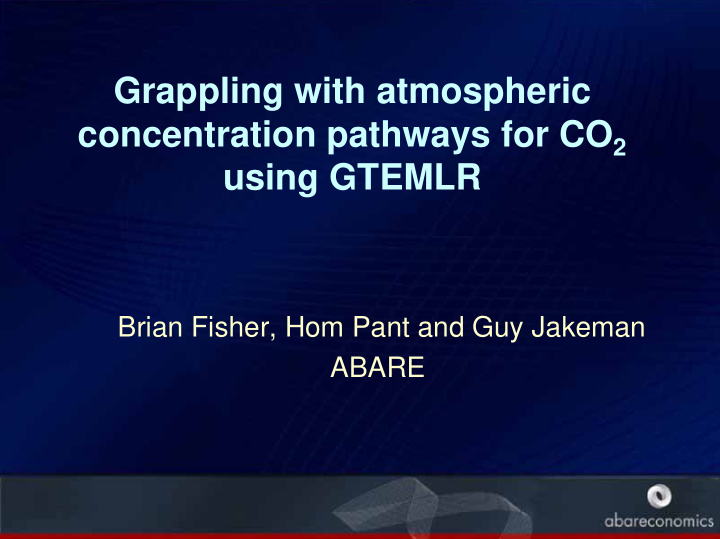



Grappling with atmospheric concentration pathways for CO 2 using GTEMLR Brian Fisher, Hom Pant and Guy Jakeman ABARE
Question: How would paths of global emissions and atmospheric concentration of CO 2 look like by 2100 if the world economic growth follows SRES A1 path?
We answer the question under the following three scenarios: • Emissions efficiency improves globally by 2.5% per year • Emission intensity of non-OECD regions catches up the intensity of OECD 2000 by 2040 and maintain EEI at 2.5% pa • Non-OECD regions delay until 2020 and then maintain EEI at 2.5% pa
Scenario 1: Global emission intensity reduction by 2.5% pa We consider the following 4 cases: - Global emissions efficiency improvement of 2.5% pa - Emissions efficiency improvement of 1.5% + energy intensity decline by 1% per year - SRES A1FI - SRES A1B
Concentrations calculated using Maier-Reimer Hasselmann box model except SRES A1FI calculated using ISAM REF.
Scenario 2: Non-OECD regions Catch-up by 2040 We compare the following 4 cases: - Global emission efficiency improvement (EEI) of 2.5% pa - OECD with 2.5% pa EEI and non-OECD regions catching up OECD emission intensity of 2000 by 2040 and then maintain global average of 2.5% pa EEI - SRES A1FI - SRES A1B
Concentrations calculated using Maier-Reimer Hasselmann box model except SRES A1FI calculated using ISAM REF.
Scenario 3: Non-OECD regions delay until 2020 We compare the following 3 cases: - Global emission efficiency improvement (EEI) of 2.5% pa - OECD with 2.5% pa EEI and non- OECD regions delay actions until 2020 and then maintain 2.5% pa EEI - SRES A1FI
Concentrations calculated using Maier-Reimer Hasselmann box model except SRES A1FI calculated using ISAM REF.
Some observations • Irrespective of the eventual technological path a 2.5% pa reduction in emission intensity is necessary to attain atmospheric concentration level of CO 2 below 1000ppmv by 2100, given SRES A1 growth path • 1.5% pa reduction in energy intensity and 0.5% pa reduction in emission intensity has been historically observed (IEA 2002) – implies some additional action is required.
Some Observations… • Taking into account thermal efficiency limits, emission intensity reduction via carbon capture, sequestration and cleaner technologies appear necessary. • As a rough guide – reduction in emission intensity at a rate higher than the economic growth rate will lead to decline in total emissions • Delayed action by any party adds to the burden
Recommend
More recommend